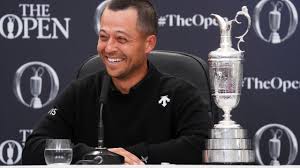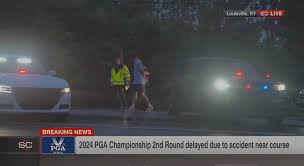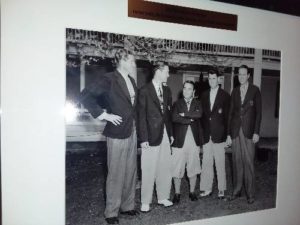
CHARLOTTE, NC – Like an archaeologist wide-eyed with wonder as he finally deciphers ancient hieroglyphics on a graven monument, so too was I mesmerized by the photos on the walls of venerable Canterbury Golf Club in Cleveland, Ohio. They depicted a more civilized age, the heady halcyon time during which the PGA Championship was born, an Interwar America hurtling through the Roaring ’20s, never suspecting that the Great Depression would ravage not only our country’s economy, but that of he whole world. And with the right kind of eyes, you could almost see the story they told unfolding before your eyes.
Although they were almost a century old, Canterbury had preserved the photos remarkably well, so clear and true-to-life the figures in them almost seemed real. There they were, captured forever, all the stars of the 20s 30s and 40s gracing the walls of the club, glittering with all the luminescence of the Milky Way.
There was Gene Sarazen, standing in the exact middle of a photo of the first five winners of the Masters – Hprton Smith and Craig Wood on one side, Byron Nelson and Henry Picard on the other, and poor Sarazen, dwarfed so totally by the trees standing around him that he looked more like a Hobbit setting out from Rivendell than a six-time major championship winning golfer.
But as Sauron found out the hard way, you have to watch out for Hobbits: judge one not by one’s size: Sarazen won three PGA Championships and two U.S. Opens besides that 1935 Masters where he double-eagled 15, still one of the greatest single shots in golf history. He was the second back-to-back winner of the PGA Championship in 1922 and 1923, and he was the first golfer to complete the career Grand Slam – quite a feat for the son of Sicilian immigrants, (his real name was Eugenio Saracenzo), a former caddie, and club professional. After all, club pros were treated like servants back in those days. Luckily, W.C. Fownes, the visionary behind Oakmont took a liking to a 22-year old Sarazen, who was then working at nearby Titusville Country Club. He paid Sarazen’s expenses to go out to Skokie Country Club outside Chicago so Sarazen could practice before winning that ’22 Open.
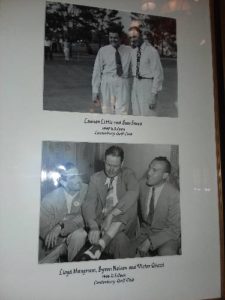
In yet another photo, there are Vic Ghezzi, Byron Nelson, and Lloyd Mangrum changing their shoes in preparation for the post-tournament awards ceremony after the 1946 U.S. Open. The trio looks more like the Rat Pack than golfers, each with movie star looks and dressed impeccably, a difficult thing to do after contesting an 18-hole playoff through a thunder and lightning storm that boomed and roared like the Last Judgment in the Book of Revelations.
Nelson was the reigning PGA champion at the time of that photo. He had won the previous year at Dayton, Ohio’s Moraine Country Club, now brilliantly renovated by designer Keith Foster. That victory was the ninth of his record 11 consecutive PGA Tour wins. He also won the PGA in 1940 at Hershey Country Club. Ghezzi also was a PGA Champion, in 1941, defeating Nelson in the final at Cherry Hills in Denver, one of three final round defeats Nelson absorbed in his PGA Championship career.
It was Mangrum, though, who had the widest smile in that photo; he had just defeated both Nelson and Ghezzi in the playoff. Some people like to sometimes refer to him as “Lloyd Mangled” because he survived being wounded three times during World War II. Unlike Sam Snead or Ben Hogan, who took stateside jobs as pros on army base golf courses, Mangrum took a bullet for his country during the invasion of Normandy, had a sniper’s bullet pass through his leg during the Battle of the Bulge and then survived a horrific accident where a Jeep overturned on him. After that, tournament golf didn’t seem too difficult.
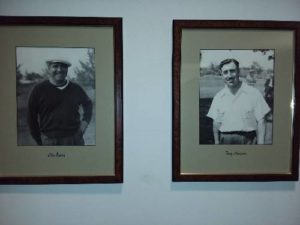
So many other luminaries grace the walls, the club could double as a Hall of Fame of the Golden Age. Portly Olin Dutra looks more like a grocer than a golfer, but he won a PGA Championship in 1932 at Minnesota’s Keller Golf Course and U.S. Open in 1934 at Merion. Strapping young Johnny Revolta beat Tommy Armour in the 1935 PGA Championship final at Perry Maxwell’s Twin Hills in Oklahoma. And Tony Manero, with his pencil-thin moustache, looks like he should either be in a director’s chair barking “action” into a megaphone, or landing his plane in the fairway of the 18th hole at Riviera rather than winning the 1936 U.S. Open at Baltusrol on the only occasion where the championship was staged on the Upper Course.
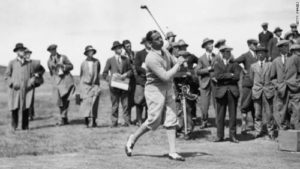
Of course, no discussion of the PGA’s formative years is complete without mentioning Walter Hagen, a five-time winner, including four consecutive wins between 1924-1927. He had quite the stranglehold on the Wanamaker Trophy in those days…to strong perhaps, because in 1928 when Leo Diegel upended Al Espinosa in the final 6&5 at Baltimore Country Club (Five Farms Course), Hagen had to sheepishly admit he didn’t have the trophy to give back for the awards presentation. He’d lost it in a taxicab in St. Louis he said.
Diegel did receive a new Wanamaker Trophy when he repeated as champion in 1929, besting a crew-neck wearing Johnny Farrell 6&4 at Hillcrest in Los Angeles. (A comma of hair always dangled awkwardly over Farrell’s eyes in every picture.) But the most interesting aspect of the story occurred many years later, as construction crews in Detroit were demolishing a building and found a mysterious unmarked trunk. When they opened it – SHAZAM! – there’s the Wanamaker Trophy, gleaming bright.
Whose building were they tearing down? The Walter Hagen Golf Club Manufacturing Company.
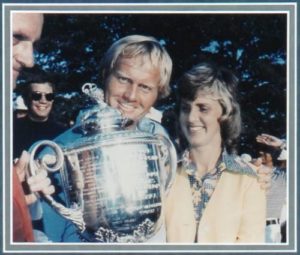
Canterbury holds a special place in golf history for another reason; it’s the course where Jack Nicklaus broke Ben Hogan’s major championship record. The 1973 PGA was Nicklaus’s 14th major, and the story goes that Jack and his pals were slated to go hunting in Montana that November. But one of his pals was concerned about Jack’s chances for sole possession of the most important mark in professional golf. He asked Nicklaus if he shouldn’t postpone the trip, because if Jack didn’t win at Canterbury, he’d want to practice in preparation for the ’74 Masters, the next chance to break the mark.
After a moment’s deliberation, Nicklaus simply remarked, “Book the hunt,” sending an unmistakable message that he was singularly focused on winning. Nicklaus didn’t just win. He shattered the record for largest margin of victory in a PGA Championship, winning by a whopping 7 shots, eclipsed only recently, in 2012, by Rory McIlroy at Kiawah Island. Ever since then, “Book the hunt” entered into golf lore as a catchphrase, while the timeless photo of Jack and Barbara captures them young, bright-eyed, blonde, and victorious.
And so it was with a twinge of sadness when I had to tear myself away from my impromptu history lesson that day. That’s one of the beautiful things about our game; we don’t just stroll around dazzlingly beautiful landscapes, but we also walk in history, and here was history, speaking to me, in a high clear voice, echoing through a century, those Kodachrome moments captured forever like a Paul Simon song – making it seem all the world’s a sunny day.
So as we sit here on the eve of the season’s last major, bending spoons with Dustin Johnson (his golf bag gives smarter, more interesting interviews tha he does), sniggering at Phil and Ernie’s white, scrawny shins, (in short…they look silly), and cringing as King of the Grunge Punks Justin Bieber yuks it up on the practice range with Bubba Watson, we can at least reflect upon the tournament’s illustrious history. Some golfers of our age are mere dwarves when measured against the giants on whose shoulders they stand, but if they win a major, it’s surprising how much grace and class the media can impart to them. Sometimes they’ll deserve the accolades, sometimes we’ll overstate the case, but when all else fails, just take a picture…it’ll last longer.


